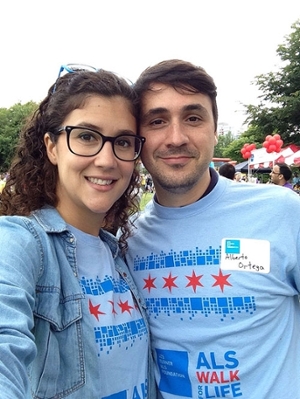‘Organic interactions’ grow into new discoveries
We come from very different communities and we both have learned a great deal about physical and biological phenomena through our joint work. Beyond our initial publications, there is a lot more exciting work coming from this organic collaboration at the Simpson Querrey Institute.”
Samuel I. Stupp
Simpson Querrey Institute, Director
Global researchers form lasting collaboration at SQI
When Evangelos Kiskinis, neurology and physiology, joined the Northwestern faculty in 2015, he had heard of Samuel Stupp but never worked with him.
An international leader in self-assembling materials and supramolecular chemistry who was born in Costa Rica, Stupp, director of Northwestern’s Simpson Querrey Institute (SQI), had never even met the Greek-born Kiskinis. That all changed about two years ago thanks to another relationship that began taking shape in Spain.
Zaida Alvarez-Pinto and J. Alberto Ortega were pursuing their PhDs when they met at the University of Barcelona in 2009. The pair shared a passion for traveling, food, and a career in research. Today, as postdoctoral fellows at Northwestern — and husband and wife — Alvarez-Pinto, who works in the Stupp lab, and Ortega, who works in the Kiskinis lab, have helped forge a connection between the two principal investigators.
“Because we have common scientific interests and we love our jobs, we constantly share what we do in the lab, and discuss how the other might answer questions we want to address,” says Ortega. “One Saturday, Zaida returned home from a Stupp lab meeting, and we began to discuss some of the problems when culturing induced pluripotent stem cell (iPSC)-derived neurons.”
IPSCs originate from skin or blood cells that have been reprogrammed into an embryonic-like state. These stem cells can then mature into any type of human cell — a neuron for instance.
The initial problem Ortega described was that human neurons cultured alone for long periods of time tend to aggregate and look terribly unhealthy and immature.
“Zaida pointed out that neurons, and especially human neurons, have a very low capacity to produce extracellular matrix, so the lack of a supportive environment produces all these problems,” Ortega recalls.
In her research, Alvarez-Pinto uses peptide amphiphiles, self-assembled molecules commonly utilized in the Stupp lab, that resemble the extracellular matrix.
Ortega wondered if the material might make the iPSC-derived neurons used in the Kiskinis lab look more physiologically sound. Each postdoc proposed the idea to their respective PIs and after agreement about 18 months ago, the labs began rapidly testing the concept. As of today, two publications have resulted, the first of which highlighted the discovery of a supramolecular nanostructure that mimics a brain-derived neurotrophic factor.
“The partnership is a natural fit between a stem cell lab interested in developing models of disease and discovering therapeutics and Sam’s lab that develops regenerative and therapeutic materials,” says Kiskinis, now a member of SQI whose most recent publication with Stupp explored Peptide–siRNA Supramolecular Particles for Neural Cell Transfection.
The experiments have already transitioned from mouse to human neurons, and in one project the team is learning through electrophysiology about how the Stupp lab’s highly designed synthetic scaffolds can directly impact the maturation and excitability of neuronal networks.
“Our partnership with Evangelos’ lab has been nothing short of fantastic scientific synergy," says Stupp, Board of Trustees Professor of Materials Science, Chemistry, Medicine, and Biomedical Engineering. “We come from very different communities and we both have learned a great deal about physical and biological phenomena through our joint work. Beyond our initial publications, there is a lot more exciting work coming from this organic collaboration at the Simpson Querrey Institute.”

